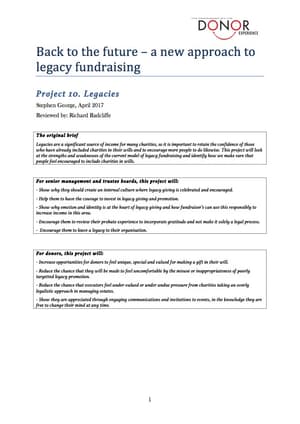CDE project 10 section 4 part 1: the approach used in this report and the basis for these conclusions
- Written by
- The Commission on the Donor Experience
- Added
- April 27, 2017
To draw together some inputs, ideas and contributions that shaped some of the conclusions and recommendations in this paper, we have organised the collection of insights around four areas that can affect legacy fundraising from the position of the donor, and which provide insight into the position of the fundraiser – donors, organisations, marketing and legacy administration.
d. The needs and experience of donors and their families – seeing it from the donor’s viewpoint
e. Different organisations’ cultures, capacities and experiences – seeing it from the organisations’ viewpoints
f. The legacy marketing and influence method and experience – seeing it from the ways that fundraisers fundraise
g. The probate experience and approach – seeing it from the experience of the donor and of the charity when families engage with a charity through probate (Probate is the legal process whereby a will is "proved" in a court and accepted as a valid public document that is the true last testament of the deceased – Wikipedia).
This was explored by asking participants to define
h. What works, inspires and provides a positive experience?
i. What prevents the delivery of an inspiring and positive experience?
j. How could fundraisers make this experience remarkable at present and in the future?
A survey was created using Survey Monkey, and was distributed via the Institute of Fundraising Legacy and the In Memoriam Special Interest Group, as well as on Facebook, Fundraising Chat, LinkedIn and via blog posts on UK Fundraising during the summer of 2016. Findings and feedback were collated and used to distil the recommended actions. Specific individual heads of legacy fundraising were emailed as part of the IOF Special Interest Group, while Remember a Charity sent its 160 members the questionnaire. The four case studies were identified (presented in the appendices) as part of this.
The content in this report draws upon the authors’ experience and background knowledge, as well as on perspectives from others (referenced throughout) to illustrate the thrust of the paper and to support the conclusions.
The following sections relate to the four areas (the donor, the organisation, marketing and legacy administration), beginning with an overview of and perspective on each, followed by a series of defined recommendations and a narrative to explain.


















